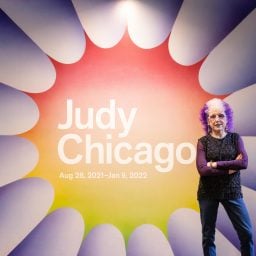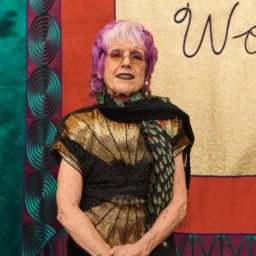Judy Chicago’s most famous work, The Dinner Party, was, quite literally, about offering women a seat at the table. Now, it would seem that the art world has finally set a place for the great feminist artist herself, poised to acknowledge her decades of work beyond The Dinner Party.
“It is incredibly gratifying to me to have put my faith in art history and have art history finally be on my side,” Chicago told Artnet News on a walk through her current show at the Institute of Contemporary Art, Miami.
Earlier this month during Miami Art Week, Chicago was everywhere. She had work at Art Basel Miami Beach with San Francisco’s Jessica Silverman Gallery and New York’s Salon 94, which offered, among other pieces, her large-scale 1985 textile work EU-69 Mother India for $825,000.
In Miami’s Little Haiti neighborhood, Nina Johnson mounted “Judy Chicago: Atmospheres.” Over in the Design District, she was one of only a handful of women in Jeffrey Deitch and Larry Gagosian’s white male-dominated “Pop Minimalism Minimalist Pop,” and she took over an entire floor of the ICA Miami with “Judy Chicago: A Reckoning,” a survey curated by museum artistic director Alex Gartenfeld and associate curator Stephanie Seidel.
It was only the second time that Chicago and her husband, photographer Donald Woodman, ha d ever been to Miami for the fair—the last was back in 2004 or 2005, when they almost didn’t make it past the door girls at a Yoko Ono performance—and it was clear that it wasn’t exactly her scene: “I don’t know when art became a carnival,” Chicago said.
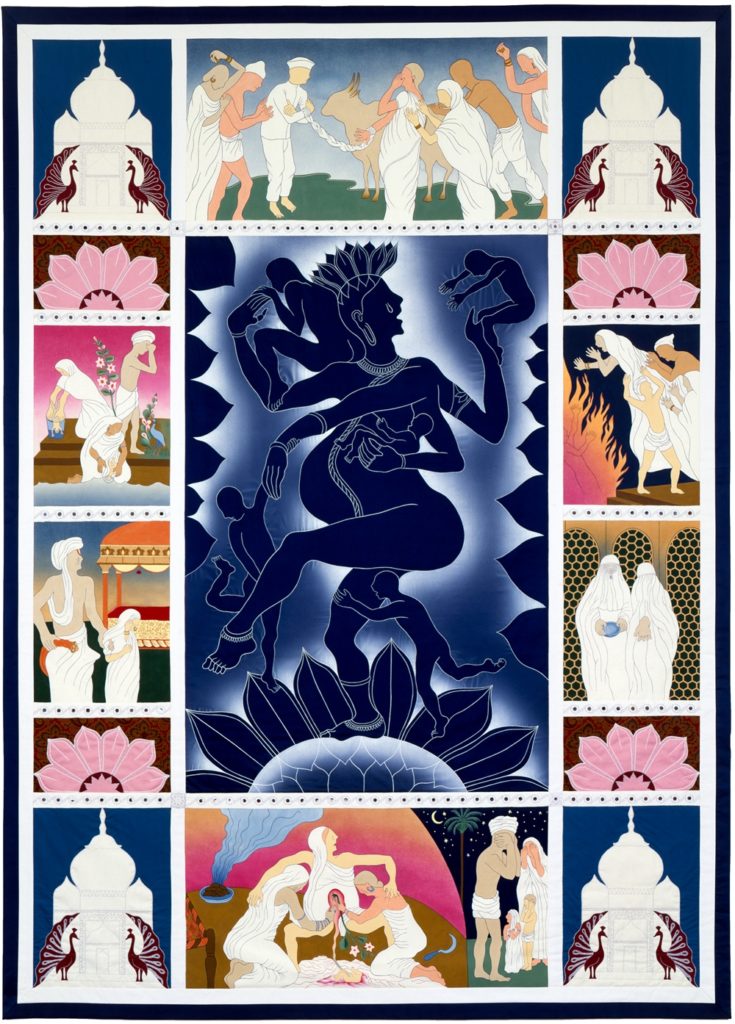
Judy Chicago, EU-69 Mother India (1985). Image courtesy of the artist and Salon 94, New York.
Despite Chicago’s undeniable fame, she’s always been on the fringes of the mainstream art world, and her current level of visibility was hard won. (She called it “a miracle that I am here.”)
The Dinner Party was a grassroots success, funded by $5 donations from ordinary people who believed in Chicago’s vision, and her mission to restore the accomplishments of women to the historical record. Conservatives found her controversial vagina plates obscene, and most museums opted out of showing the work, leaving Chicago to cobble together a ten-year international tour at unconventional, non-institutional venues.
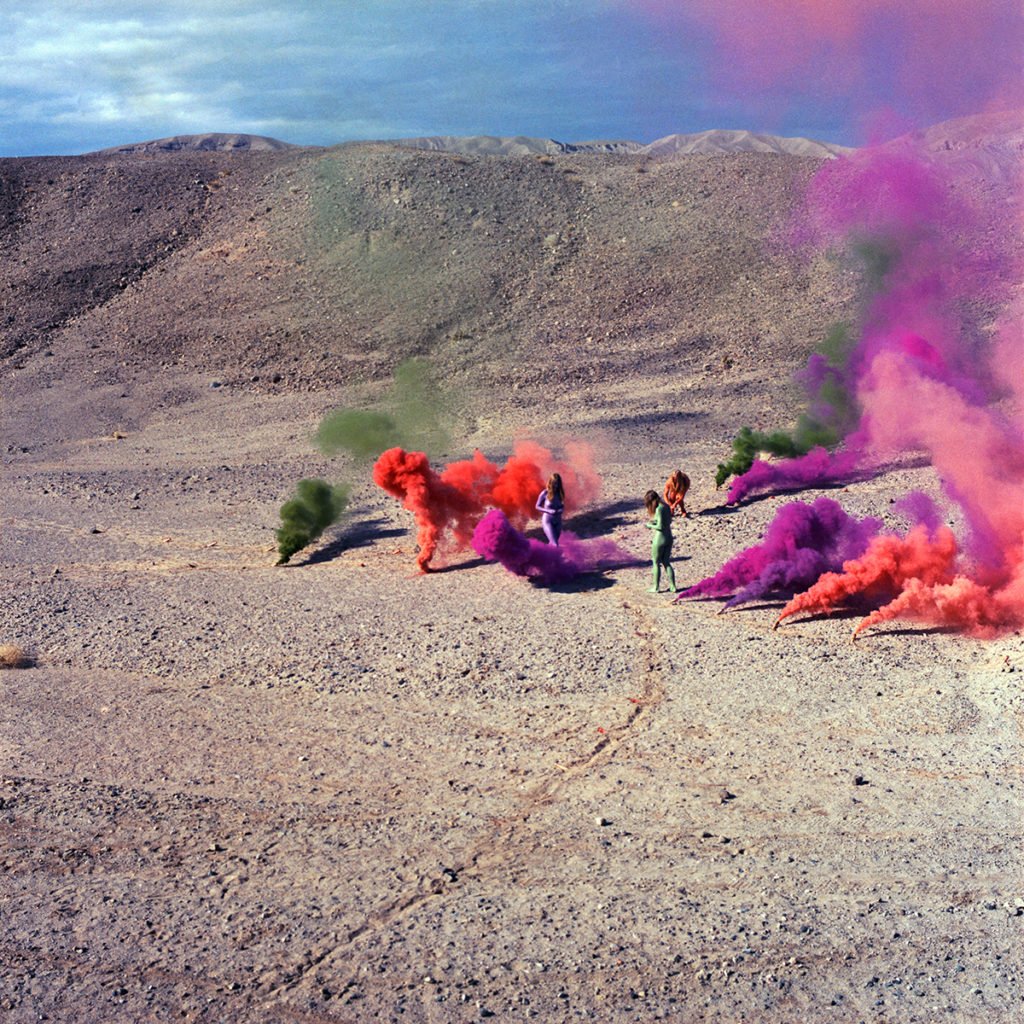
Judy Chicago, Smoke Bodies (1972); from Women and Smoke (2018). Photo courtesy of Nina Johnson.
“The art world was determined to avert its eyes,” Chicago recalled. “Nobody’s objecting to the phallus, but oh my god, the dreaded vagina!” (She also marveled at the overtly sexual artwork she sees young feminist artists sharing on Instagram today: “I’m really like, so mild!”)
The Next Battleground
With the exhibition open and her status cemented, Chicago is now turning her focus to the future. Lest you think she has won all her battles, she’s currently in the thick of what she’s dubbed the Belen Brouhaha, over a potential art space in her longtime home of Belen, New Mexico.
The former mayor—also the town hairdresser, Chicago is delighted to point out—had suggested that Chicago and Woodman convert a building owned by her Through the Flower nonprofit into an art space, with an exhibition telling the story of their lives. The town was set to provide a part-time employee, and to assist with setting up part of the space as a book and video library. That’s when, as Chicago put it, “all hell broke loose.”
“There’s a very entrenched right-wing religious group in Belen,” Chicago explained. Evangelicals tried to halt the project, calling her work pornographic. “I guess we really riled up the patriarchy!”
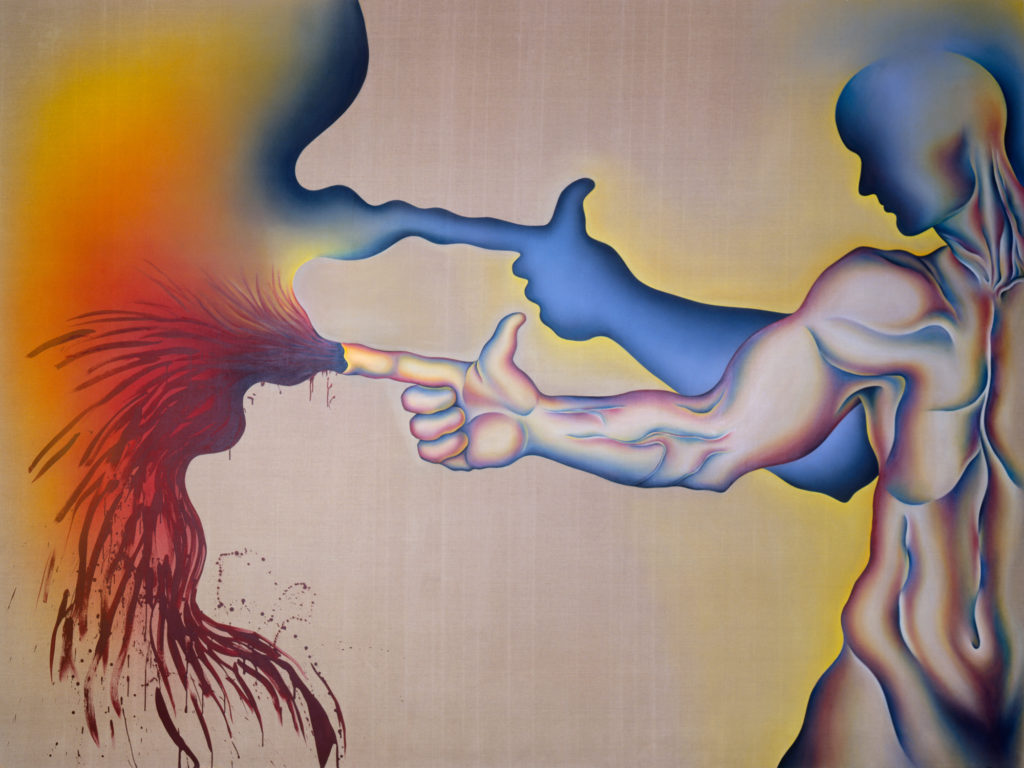
Judy Chicago, In the Shadow of the Handgun (1983). ©Judy Chicago.
She no longer plans to partner with the city, but is still moving ahead with plans for the Through the Flower Art Space—and Belen’s mayor, Jerah Cordova, has pledged to donate his entire 2019 salary, or about $10,000 after taxes, in support of the fledgling institution.
For Chicago, the whole controversy is very much a reflection of where we are as a country, and the “inability to have a dialogue.”
“We have seen the power of the religious right and how they are pushing our country backwards, and that same battle is going on in our town,” she said. “It’s the new normal.”
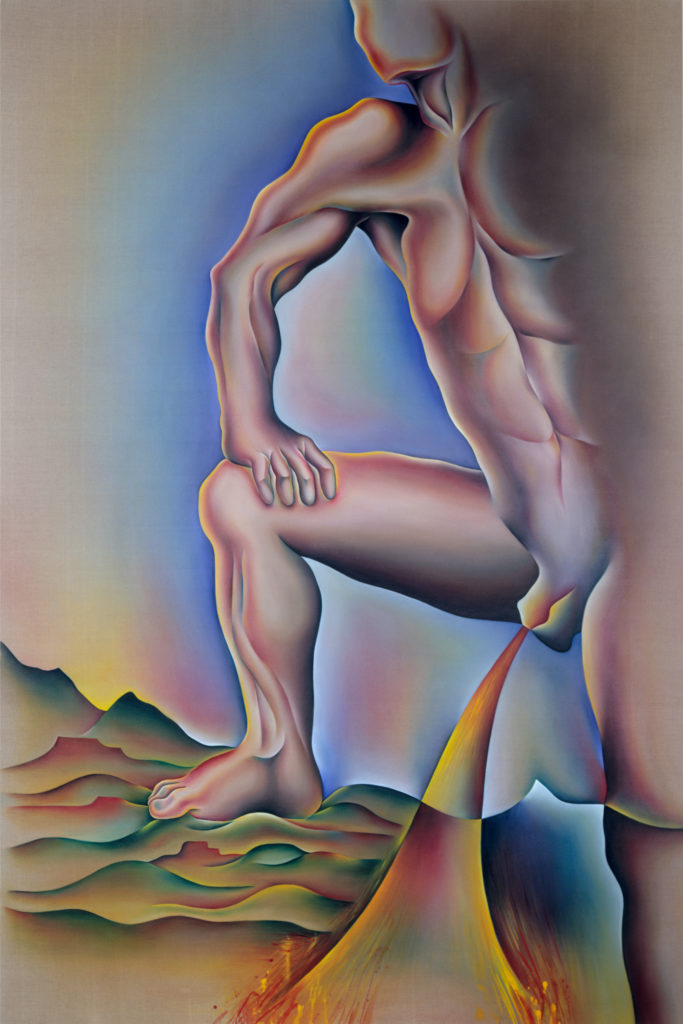
Judy Chicago, Pissing on Nature (1984). ©Judy Chicago.
She also sees parallels in the surprising timeliness of some of the works at the ICA, particularly the three monumental paintings from the “PowerPlay” series, which critique the destructive nature of the male ego. Chicago is quick to point out that In the Shadow of the Handgun (1983) calls to mind the current epidemic of mass shootings, while Pissing on Nature (1984) seems to presage President Donald Trump’s gutting of environmental protections.
A Fuller Picture
Chicago’s environmentalist bent is also on display at Nina Johnson, which is showing largely never-before-seen photo prints from her colorful, feminist-tinged landscape performance art pieces of 1968–74, with fireworks in the desert ignited by naked women, their bodies painted to match the colorful plumes of smoke.
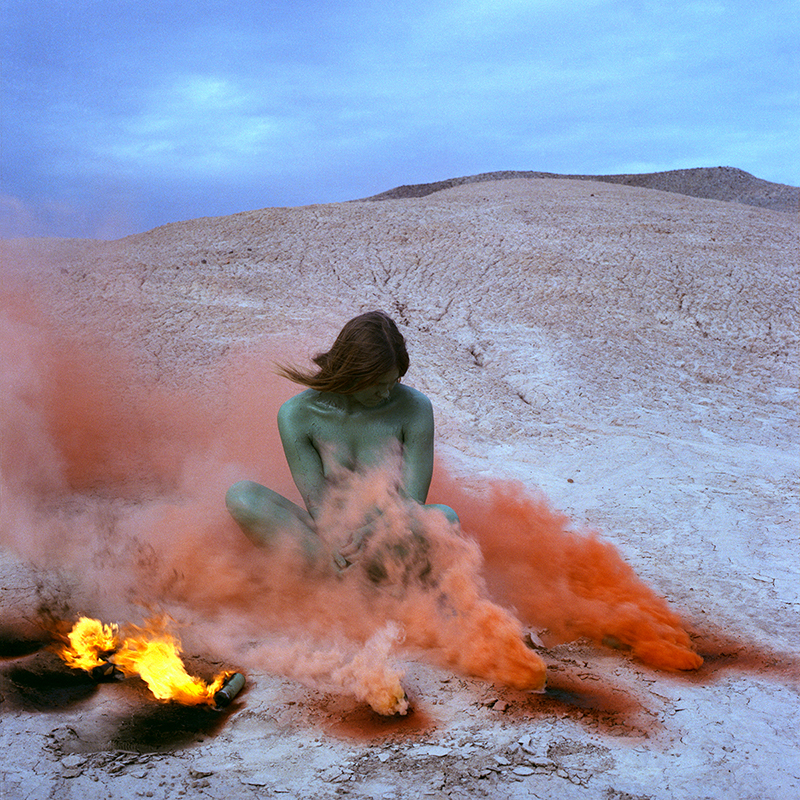
Judy Chicago, Immolation (1972); from Women and Smoke (2018). Photo courtesy of Nina Johnson.
“That work of course merges flesh and landscape, and if it leaves any mark, it’s like a little black mark on the ground from the flares or something. It’s nothing like knocking down the redwoods or plowing up the earth,” Chicago said, iterating her intense dislike of Richard Serra’s 1970 piece sawing up four massive California redwood logs at the Pasadena Art Museum.
If the ICA presentation serves to underscore Chicago’s continued relevance, it still stings that her feminist art of the 1970s, groundbreaking as it was, has been lampooned as dated. Chicago was thrilled, therefore, when the museum decided to include her piece Heaven Is for White Men Only (1973) in the exhibition.
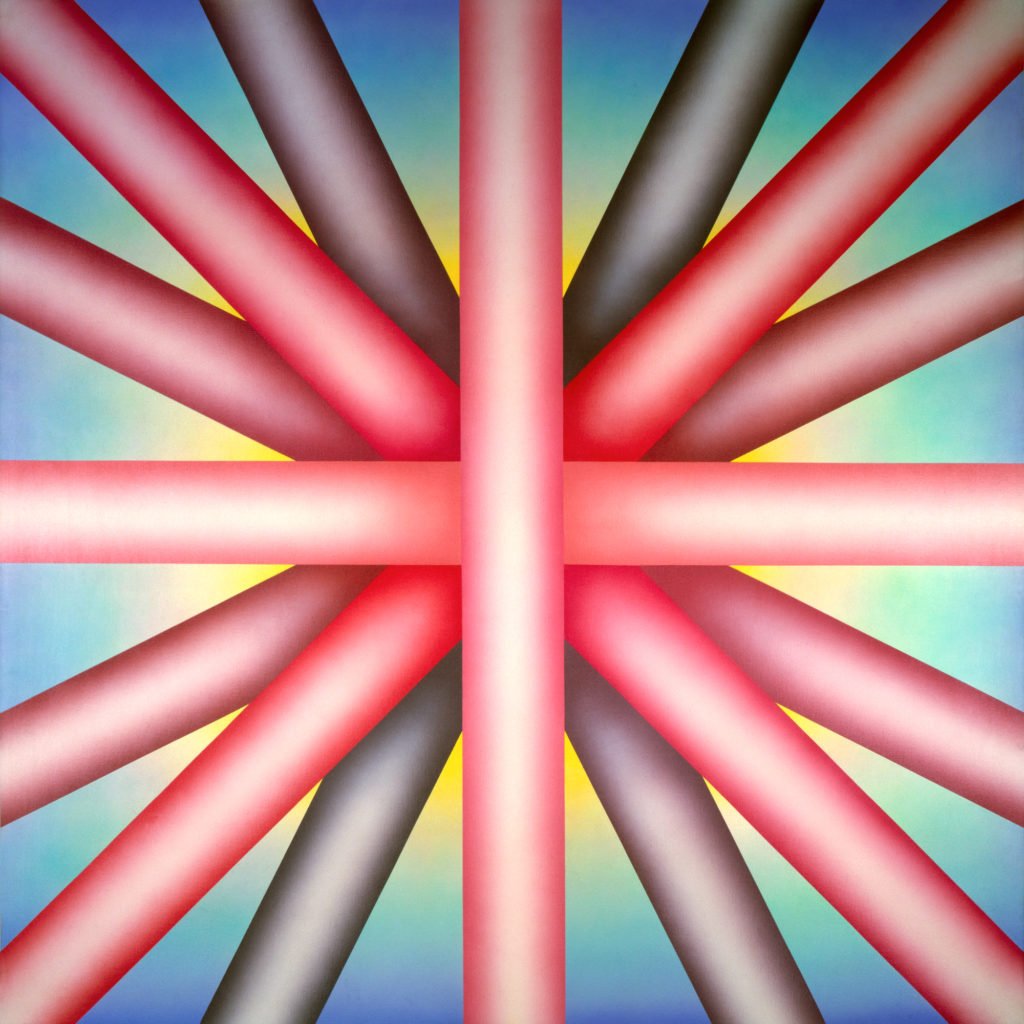
Judy Chicago, Heaven is for White Men Only (1973). Courtesy of Salon 94 and the artist.
“I read a lot of critiques about us relic feminists from the 1970s and how we didn’t understand intersectionality. And I’m like, ‘excuse me?’ This is a series of flesh bars of different colors suggesting that it is your gender and your color that determines whether you can get into heaven,” she said. “It’s about the intersection of race and gender and how it inhibits some people’s freedom.”
Another difficulty Chicago has faced is the lack of critical understanding of many of the mediums in which she works. When she was in art school, there were no shortage of painting classes, but not one was about “painting” with thread, or traditionally feminine fiber arts.
“What women do has been ignored historically and continues to be ignored in our institutions,” Chicago said. “One of thing that I talk a lot about is institutional failure—the failure to pass on women’s history and feminist art history.”

Judy Chicago, Earth Birth (1983). Courtesy the artist.
She is happy to see the current resurgence in textile arts, but she would like art critics and experts to develop a critical eye to better differentiate between work that is well done or poorly executed. (The ICA show includes textile-based work from Chicago’s series “The Birth Project,” which celebrates the primacy of women in the act of giving birth, an event rarely depicted in art history.)
Chicago also laments the lack of broad art-world understanding of different needlework techniques, which range from needlepoint, done on a gridded canvas, to embroidery, carried out freehand with many needles simultaneously threaded in different colors, almost like a palette of paint. As part of the “area of the ignored,” such distinctions aren’t taught, unlike, say, the difference between spray paint and oil paint.
It’s just one of many ways in which she’s still waiting for the rest of the world to catch up with the work she’s been making for decades. Chicago’s market, for instance, with an auction record of just $288,000, according to the Artnet Price Database, is something of a sore spot. (“There’s some work I’m not selling because we can’t get what I think it’s worth yet,” Chicago said. “I’d just rather keep it.”) But things are clearly heading in the right direction.
“I’m having a long-held wish come true,” Chicago admitted. “The body of my work is beginning to emerge from the shadow of The Dinner Party.”
“Judy Chicago: A Reckoning” is on view at the Institute of Contemporary Art, Miami, 61 NE 41st Street, Miami, Florida, December 4, 2018–April 21, 2019.
“Judy Chicago: Atmospheres” is on view at Nina Johnson, 6315 NW 2nd Avenue, Miami, Florida, November 18, 2018–March 2, 2019.










